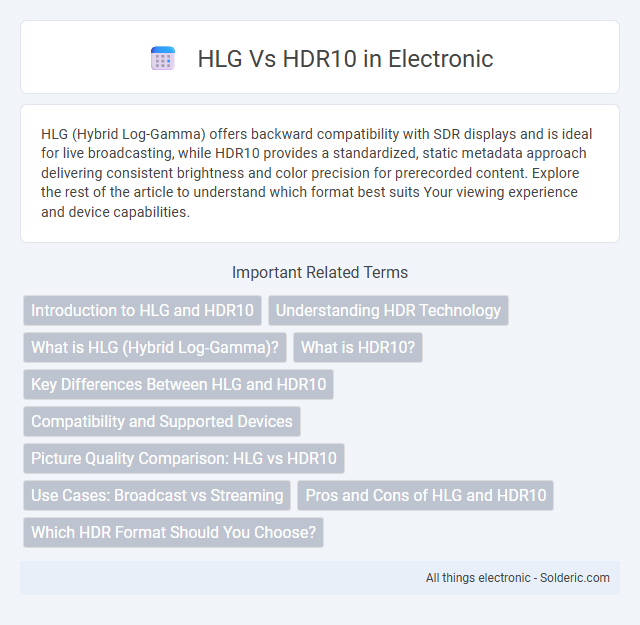HLG (Hybrid Log-Gamma) offers backward compatibility with SDR displays and is ideal for live broadcasting, while HDR10 provides a standardized, static metadata approach delivering consistent brightness and color precision for prerecorded content. Explore the rest of the article to understand which format best suits Your viewing experience and device capabilities.
Comparison Table
| Feature | HLG (Hybrid Log-Gamma) | HDR10 |
|---|---|---|
| Standard Type | Broadcast HDR Standard | Static Metadata HDR Standard |
| Metadata | No metadata, backward compatible | Static metadata (SMPTE ST 2086) |
| Peak Brightness | Typically up to 1,000 nits | Up to 1,000 nits (per content mastering) |
| Compatibility | Compatible with SDR displays | Requires HDR-compatible display |
| Use Case | Live broadcasts, streaming | Movies, UHD Blu-ray, streaming |
| Gamma Curve | Hybrid Log-Gamma curve | Per-Scene or Per-Frame PQ curve |
| Adoption | BBC, NHK, live TV | Ultra HD Blu-ray, Netflix, Amazon Prime |
Introduction to HLG and HDR10
HLG (Hybrid Log-Gamma) and HDR10 are prominent high dynamic range (HDR) standards used in modern video technology, enhancing visual quality by improving brightness, contrast, and color accuracy. HLG is designed for broadcast TV with backward compatibility on SDR displays, utilizing a gamma curve that adapts to varying lighting conditions, while HDR10 uses static metadata to define brightness levels, optimized for streaming and UHD Blu-ray content. Your choice between HLG and HDR10 depends on the intended delivery platform, viewing environment, and device compatibility for optimal HDR performance.
Understanding HDR Technology
HLG (Hybrid Log-Gamma) and HDR10 are prominent HDR technologies enhancing picture quality by increasing contrast and color depth. HLG is designed for broadcast TV compatibility, combining SDR and HDR signals without metadata, while HDR10 uses static metadata to optimize brightness and color on compatible displays. Both formats significantly improve visual experience by delivering brighter highlights and more accurate colors compared to standard dynamic range content.
What is HLG (Hybrid Log-Gamma)?
HLG (Hybrid Log-Gamma) is a high dynamic range (HDR) standard jointly developed by the BBC and NHK designed for backward compatibility with standard dynamic range (SDR) displays. Unlike HDR10, which uses static metadata, HLG dynamically adjusts the gamma curve based on the brightness of the scene, enabling seamless HDR broadcasting without the need for metadata transmission. This makes HLG ideal for live TV broadcasts and streaming services aiming to deliver enhanced contrast and color depth while maintaining compatibility across diverse display technologies.
What is HDR10?
HDR10 is a widely adopted high dynamic range (HDR) standard that enhances video quality by expanding brightness, contrast, and color depth to 10-bit color for over one billion colors. It uses static metadata, meaning the brightness and color settings are consistent throughout the entire video content, ensuring compatibility across most HDR-capable TVs and devices. HDR10 supports peak brightness levels up to 1,000 nits, delivering vivid highlights and deeper shadows for a more immersive viewing experience.
Key Differences Between HLG and HDR10
HLG (Hybrid Log-Gamma) and HDR10 are two prominent HDR formats with distinct technical frameworks and compatibility. HLG uses a logarithmic curve designed for broadcast compatibility without metadata, supporting seamless live content delivery, while HDR10 relies on static metadata to optimize peak brightness and color levels for each scene. HDR10 offers superior color depth with 10-bit color and higher peak luminance, making it ideal for streaming and UHD Blu-ray content, whereas HLG excels in real-time broadcast environments.
Compatibility and Supported Devices
HLG offers broad compatibility with live broadcast systems and is natively supported by most modern TVs, making it ideal for real-time HDR content delivery. HDR10, widely adopted across Blu-ray players, streaming devices, and gaming consoles, ensures extensive device support for high-quality static metadata HDR playback. Your choice depends on whether you prioritize live broadcast flexibility with HLG or widespread media compatibility with HDR10.
Picture Quality Comparison: HLG vs HDR10
HLG (Hybrid Log-Gamma) and HDR10 offer distinct approaches to enhancing picture quality, with HDR10 delivering static metadata that sets fixed peak brightness and color values for consistent high dynamic range performance. HLG adapts dynamically to display capabilities, making it ideal for live broadcasts and varying screen technologies by adjusting brightness and contrast in real-time. Your viewing experience benefits from HDR10's precise detail in controlled environments, while HLG provides smooth, vibrant visuals across diverse devices without needing extra metadata.
Use Cases: Broadcast vs Streaming
HLG (Hybrid Log-Gamma) is widely adopted for live broadcast television due to its backward compatibility with standard dynamic range (SDR) displays, enabling seamless transmission without metadata. HDR10, favored in streaming platforms, requires metadata to deliver precise luminance and color information, optimizing viewer experience for on-demand content with higher dynamic range. Broadcast networks prefer HLG for real-time content distribution, while streaming services leverage HDR10 to enhance playback quality and compatibility with UHD HDR displays.
Pros and Cons of HLG and HDR10
HLG (Hybrid Log-Gamma) offers backward compatibility with SDR displays and excels in live broadcast scenarios due to its dynamic range adaptability but lacks precise metadata control compared to HDR10. HDR10 delivers consistent and standardized color and brightness levels through static metadata, enhancing cinematic experiences but requires HDR-compatible devices and may struggle with content variations. Choosing between HLG and HDR10 depends on content delivery method and display technology compatibility, with HLG favored for live TV and HDR10 preferred for streaming and physical media.
Which HDR Format Should You Choose?
HLG and HDR10 are two popular HDR formats with distinct technical advantages, where HDR10 supports static metadata and wider color depth, making it ideal for consistent high-quality playback on most HDR-compatible displays. HLG is designed for live broadcast and streaming, offering backward compatibility with SDR devices and dynamic metadata for real-time scene adjustments. Your choice depends on whether you prioritize broad device compatibility and static metadata with HDR10 or live content adaptability and seamless SDR integration with HLG.
HLG vs HDR10 Infographic

 solderic.com
solderic.com